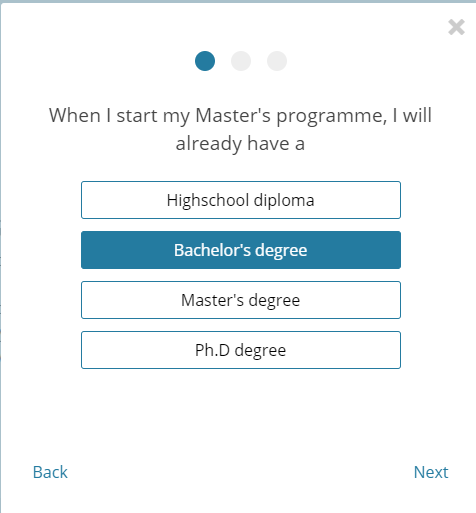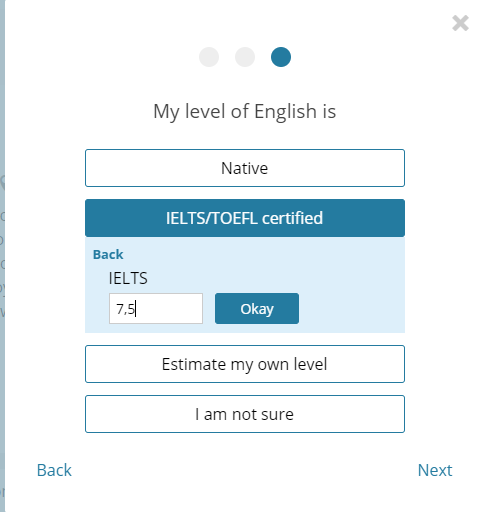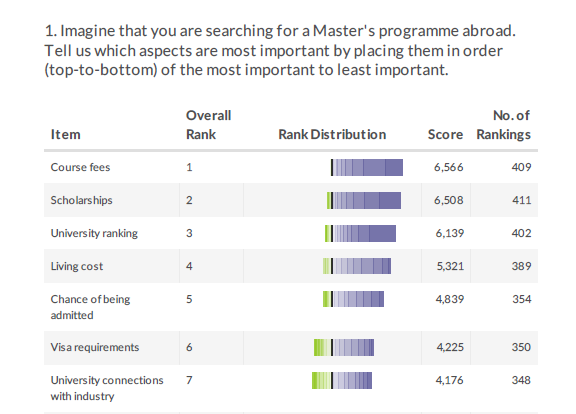Transparency to admission requirements | part 1

Over the next few weeks, we will be producing a series of articles that document the processes and steps we take towards improving and innovating our product. By understanding the student journey in and out, we’ll show how a platform can be built that is valuable to students and agile to the demands of international education.
Stay tuned and see the various insights we continue to gain as we continue to build, adapt, and create the biggest education search platform, bringing absolute transparency and reliability to international education.
Part I: Requirements match
For students, there is a lot of mystery when it comes to international education. It’s a complex process; standards and requirements are different in every country and students want to be clear about what they need and what is required of them before they apply.
Some universities will have testing requirements, while others will have a language requirement; programmes ask students to provide a GPA, while others want evidence of work experience.
Lots of students express a worry that, even if they are interested in a programme, they don’t want to spend time applying if they don’t even qualify for the programme. Moreover, admission is always a chance game – you’re applying alongside other students, from everywhere in the world, who may or may not be just as qualified as you are. For this reason, students really want to know whether they have a fighting chance of enrolling in the programme of their dreams.
So, what’s the solution that we came up with?
It’s simple! Our developers designed an easy-to-use ‘Requirements Match’ tool, asking students to basic background information to see whether they have or meet all of the requirements for to be considered for the programme they’re interested in. Though we make very clear that it’s not a guarantee for being admitted, we give students an indication whether they have the background and credentials before they apply to the programme of their choice.
How the Requirements Match checker works
Right now, on our portals, all of the programmes and universities listed include a Requirements Match checker. When prospective students land on one of the programme pages, they can now input information about their work experience and educational background. To assess their chances of being considered for the programme they’re looking at, we use six different determinants:
- Academic level
- Field of Study
- Previous university (e.g. where they received their Bachelor’s degree or Master’s degree, respectively)
- Overall grades (e.g. GPA or overall score)
- Work experience
- Language skills
With each of these determinants, we are able to estimate and crudely calculate how closely they match the requirements. Basically, each determinant is assigned a value. That value is pulled from admission experts who tell us precisely how much weight each determinant has, depending on the country, institution, or discipline. Once each student puts in his or her background information, these values are factored and compared alongside the student’s information and how well they match. At the end of it all, we are able to come up with a result: how much he or she matches to the admission requirements.

They’re prompted to fill in information about language testing scores, GPA, work experience, and standardised testing scores. Each of the panels we ask students fill out is similar to what they can expect to find on a standard university application. Our thought it: so long as they have the information and can provide it here, they should feel comfortable with applying to the university or programme of their choice.

When the information is filled in completely, students are given an immediate assessment: High, Medium, or Low. Students can then determine whether, based on the assessment, they should apply for the programme they are interested in.
Essentially, so long as students meet or exceed the requirements for every aspect – language score or GPA, for example – then they will receive a score of High. If they are lacking in one respect, or the information is simply missing from our data, then students will receive a score of Medium. And, if students don’t have the proper qualifications, or do not provide the information, then the score will be Low.
Because we are not the university admission department, nor do we have any control over the decision, our Requirements Match tool is equipped to merely offer an indication of whether they are a match for the programme. Our system creates a requirements match assessment only according to how well or how closely they meet the application or admission requirements. We don’t give students any promises or guarantees about admission; rather, we’re simply interested in encouraging them to fill out an application.
Similarly, we do try to tell students that, while we do our best to give them an accurate assessment, some information may be out-of-date or missing. In this case, students are usually given a score of Medium, but with a disclaimer telling them to check with the university or programme what the requirements are for admission.
Deciding to create the requirements match tool: student survey
The choice to create the requirements match tool was not an isolated one. As we said in the previous article, our process of innovation requires flexibility and the ability to extract substantive data before we do any decisive tinkering with our product.
In this case, before we proceeded with building the requirements match tool, we conducted a survey of over 400 users, of whom a majority were university-age students who hold a Bachelor’s degree. The aim of the survey was to ask students what they expect to find when they’re using our portals to look for their Master’s degree programme abroad.
Besides the expected details – tuition fees, scholarships, university ranking, and living cost – “chance of being admitted” figured in as the 5th most important aspect, and one of the only details that we did not already provide.

Considering we already provide basic listing information about tuition and living cost, the fact that students selected “chance of being admitted” as such an important piece of information certainly piqued our interest.
Our focus for this year, encapsulated under the idea of delivering students the “best fit” information, was directed towards information that they themselves expressed a need for. The decision, therefore, to create a requirements match tool was precisely a response to this widespread need and desire among students. Devoting our energies to building this feature was consistent with our overall goal of making sure that students find the options that are best for them, while universities can also ensure that applicants are the quality applicants they are seeking.
Because we’re interested in propelling students through this journey, we want to make that passage as worry-free and simple as possible. So, if we can eliminate the anxiety and uncertainty about their applications or whether they match the admission requirements, then students are more likely to confidently take the next step towards applying.
The benefits of providing admission requirements information and transparency
As previously mentioned, students are really looking to feel comfortable and confident about pursuing their education. One way to make sure students retain their comfortable feeling is to keep them informed. Isn’t it always so refreshing when you’re booking a flight and they are forthright about what the extra fees are or what the baggage allowance is?
It’s the same when students are applying to a university. They don’t want to get all the way through an application just to find out in the end that their IELTS wasn’t high enough for them to even be considered in the first place!
So, to inspire confidence in your prospective students, this kind of feature gives them that added sense of transparency that will then compel them to apply.
If students are able to see, immediately, whether they have the background and credentials to be considered for a programme, then they would hardly hesitate to go ahead and apply – especially if your programme suits the rest of their needs. Such a tool eliminates that gap in information that restricts a students’ abilities to apply for or enrol in the programme of their choice. Along the student journey, such a tool will encourage students to go forward, and that they have everything it takes to continue their education.
Further reading: More about these series – introduction and background
For more updates, follow us!




